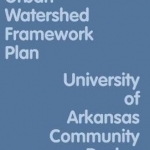Conway Urban Watershed Framework Plan
BookThis item doesn’t have any media yet
2017 | Architecture & Design
More than half of America's waterbodies are unsafe for swimming, fishing, and as sources of drinking. Why? Because of unsustainable city building and poor farming practice. Beyond water quality problems, dysfunctional streams cause flooding and erosion of property, leading to neighbourhood blights. Not only can this be reversed, but repair of degraded urban streams can be a powerful agent for reinventing the physical environments of post-industrial cities. This requires trans-disciplinary collaboration between the fields of ecological engineering and urban design. The American city was uniquely premised on fusions of landscape and urbanism: a tradition with plenty of room for innovation. However, watershed plans remain data-and-policy-driven documents with a singular interest in repairing waterbodies. They have little to say about the city and urban design. Conversely, urban planning has not codified the value of healthy ecosystems within which cities are built. In this age of the Anthropocene, when most ecosystems are human-dominated, resilient urban design must account for biological processes.
This book introduces watershed management into urban design with one simple demand: that every new development contribute to watershed stewardship, where infrastructure and building deliver ecological services in addition to urban services. The Conway Urban Watershed Framework Plan formulates a planning vocabulary for use among professionals and decision-makers to engage this new design market.
Related Items:
| Published by | Oro Editions |
| Edition | Unknown |
| ISBN | 9781939621818 |
| Language | N/A |
Images And Data Courtesy Of: Oro Editions.
This content (including text, images, videos and other media) is published and used in accordance
with Fair Use.
